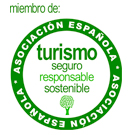El hierro, the sustainable island
The Island at the end of the world
The Canary Archipelago is located in the north part of the Atlantic Ocean, next to the west coast of Africa. It is part of the Macaronesia, a word of Greek origin meaning Happy Islands, which also includes the Azores, Madeira, Salvajes and Capo Verde Archipelagos. In the Archipelago, El Hierro is known as the Isla Chiquita (the small island), and because it continues to be far away from conventional tourist areas, it is a true paradise waiting to be discovered. It is the most western and southern island in the archipelago situated between the parallels 27° 38′ and 27° 51′ latitude north and the meridians 17° 52′ and 18° 9′ longitude west. It is 67 km from Gomera, 74 km from La Palma and 120 km from Tenerife.
Since 1933 the Faro de Orchilla has marked the westernmost point of Spain and it is still an important reference point for those who come and go, by sea, to America. Just a short distance away is the Meridian Monument, where, since the era of Ptolemy, when the world was flat and four angels held it up by its four corners, the Prime Meridian ran through, and until 1500 was the end of the known world. In 1883 the Prime Meridian was moved to Greenwich. Its surface area of 278 square km forms an upside-down isosceles triangle, whose base runs between the Punta de la Sal to the west and Punta Norte to the north, and whose vertex makes up the Punta de la Restinga to the south. For romantics, however, it has a heart-shaped form which evokes intense emotions.
The Biosphere Reserve
On 22 January 2000 the island of El Hierro was declared the Biosphere Reserve by the Unesco. Worldwide 738 reserves in more than 120 countries form an international network which includes and exceptional variety of environments and lands and offer great scenes of man and nature’s coexistence. A Biosphere Reserve is a territory that holds particular environmental value. It represents a stable and developing community which has decided that social and economic advances must take into consideration the environmental resources that sustain it. They are places where projects for sustainable development are practiced, meaning that natural and cultural resources are administered reasonably in order to leave them to future generations. To be declared such they must meet certain requirements and respect a minimum number of conditions, including conservation and sustainable development.
Every reserve, in order to improve the management and protection of natural resources and to guarantee the best possible cohabitation between man and nature, must be divided into three zones: a core area, rigorously protected; a buffer zone, which surrounds the core area and where activities related to the environment are carried out; and a transitional zone, where projects pertinent to responsible development take place.
In El Hierro these zones are divided in the following way: :
– Core area, which includes the Reserva Natural Integral de Mencafete, the Reserva Natural Integral de Los Roques de Salmor, the Reserva Natural Especial Tibataje and the Reserva Marina de La Restinga;
– Buffer zone, which includes the Parque Rural de Frontiera, the Monumento Natural Las Playas, the Paisaje Protegido Ventejis and the Paisaje Protegido Timijiraque;
– Transitional zone, the rest of the island.
In November 1997 the Program for Sustainable Development was approved by the Cabildo Insular which includes initiatives in the field of Architecture, Agriculture, the Creation of Industry, the Management of Water, the Production and Use of Energy, Recycling Solid Wastes, Transport, Local Economy, Culture and Education, Fishing and Tourism. The island truly seems to be making progress, using strategies of development which respect its nature, culture and human dignity. And this is what we all hope for!
The Wind-Hydro Power Station
The El Hierro Wind-Hydro power Station, a project completed by Gorona del Viento El Hierro S.A., aims to provide El Hierro Island with electricity based on clean, renewable energy sources, namely water and wind. A wind farm produces energy that is conducted to the island’s electrical grid to meet the needs of the population. Excess energy that is not directly consumed by the population will be used to pump water between two reservoirs at different altitudes.
At times without winds, the water collected in the upper reservoir is released to the hydroelectric plant to generate electricity using water turbines. This serves to transform an intermittent, variable energy source into a controlled and constant supply of electricity that guarantees electrical grid stability and maximise the benefits from renewable sources. The diesel power plant will only be used exceptionally or in emergency circumstances when there is not enough wind or water to produce the necessary energy.
Geopark
A Geopark is a territory with a significant geological heritage of scientific value, uniqueness or educational merit, besides other cultural and natural heritage elements. These territorial values are managed using a strategy tried and tested in 30 different countries, which is based on local sustainable development. For these reasons, a Geopark is not just a geological park or another figure of territorial protection, nor does it signify more restrictions on economic development. It is considered to be a new model for socio-economic development in rural areas.
The island looks like a 5,500 m high block which shoots up from the depths of the ocean. It is the youngest of the Canary Islands, and surfaced only 1.000,000 years ago.
But much earlier violent volcanic eruptions below sea level had begun forming its base. Finally it emerged from the ocean forming a majestic triangular pyramid with a volcano over 2,000 meters high. About 50,000 years ago one of the most violent and devastating natural phenomena known to man took place and radically changed its form. In a matter of seconds a gigantic landslide, most likely caused by an earthquake, made over 300 km3 of matter fall into the sea. Thus the imposing natural amphitheater, El Golfo, was formed. It is believed that this movement created a tsunami over 100 meters high which reached the American coasts. El Hierro has the greatest number of volcanoes in the Canaries, with more than 500 visible cones and over 300 covered by more recent eruptions.
Climate
The variety of atmospheric conditions on such a small island is incredible. Just like its older sister Tenerife, El Hierro is known as the small continent, in which persistent winds, thick fog, spectacular cloud movement, rain and sunshine frequently alternate. The island is influenced by a mass of air that, depending on where it comes from, brings different types of weather. During just about the whole year moderate or strong winds blow. The Trade Winds, which come from the north-east and form in the Azorre’s anticyclone, arrive filled with water, and condense against the steep slopes of the mountains on the north side, causing horizontal rain.
During the period which goes from November to March, there is the highest rainfall. The south side, protected by winds, offers a wormer climate with rare precipitations. The Saharan winds are warm and dry and can blow in every season of the year, making the atmosphere cloudy because of the sand brought with it from the desert. This climatic condition is called calima, and temperatures can reach 35 degrees centigrade. Yet the temperate climate is caused by the interaction of the winds with the sea breezes. The ocean current in the Canaries is the southern branch of the Gulf current which creates a pleasant temperature which varies from 19° and 26° centigrade on the coastal strip and gradually decreases depending on the altitude, with sea temperatures which rarely fall below 19° centigrade.





